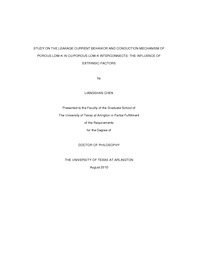
ATTENTION: The works hosted here are being migrated to a new repository that will consolidate resources, improve discoverability, and better show UTA's research impact on the global community. We will update authors as the migration progresses. Please see MavMatrix for more information.
Show simple item record
| dc.contributor.author | Chen, Liangshan | en_US |
| dc.date.accessioned | 2010-11-01T21:29:09Z | |
| dc.date.available | 2010-11-01T21:29:09Z | |
| dc.date.issued | 2010-11-01 | |
| dc.date.submitted | January 2010 | en_US |
| dc.identifier.other | DISS-10822 | en_US |
| dc.identifier.uri | http://hdl.handle.net/10106/5182 | |
| dc.description.abstract | This study investigates the influence of extrinsic factors including moisture and impurities trapped in porous low-k (PLK) and defective diffusion barrier on the leakage current behavior and the associated conduction mechanism of PLK in advanced Cu/PLK interconnects. For this purpose, a voltammetry technique that was previously developed for diffusion barrier characterization was extended to detect the trapped impurities in PLK. With this technique in hand, the influence of extrinsic factors was then studied. Cu was found to diffuse out into PLK through barrier defects in the presence of electric stress. Its out-diffusion and subsequent migration in PLK manifested as a unique hump behavior in the leakage current under moderate testing conditions, i. e. room temperature and intermediate electrical field (0.2 - 0.8MV/cm). The mechanism behind such a current hump was revealed to be the space-charge-limited (SCL) transient current. With the theory of SCL mechanism, the mobility of Cu ions in the PLKs used in this study was estimated to be as high as 10-13cm2/V-sec at room temperature. Due to the high mobility of Cu ions in PLK, aggressive testing conditions tend to make the signature of Cu out-diffusion in the leakage current too short to detect. With the understanding on the influence of Cu out-diffusion in the leakage current, a step mode current-time method was developed to study the electrical stress induced barrier failure in Cu/PLK interconnects. The barrier failure was found to be triggered by a critical electrical stress: only when the applied stress was above a critical point can diffusion barrier failure take place. Interestingly, the critical stress was further revealed to be pattern-density dependent, which was attributed to the pattern-density dependent barrier quality created during fabrication processes: due to the thermomechanical property mismatch between Cu and PLK, compressive stress that is primarily determined by the mechanically stronger Cu is developed and acts on the diffusion barrier during thermal loading cycles, creating barrier roughing with weak spots that favor Cu out-diffusion. When impurities and defective barrier presented, moisture was found to create a current peak in voltage-ramp measurement. The mechanism for this current peak was revealed to be the electrochemical reaction between moisture activated impurities and the metallic electrode. Such an electrochemical reaction can happen in two different situations. For samples with defective barrier, reaction takes place between exposed Cu and moisture-impurity electrolyte. For samples containing some specific impurities in PLK, reaction can take place between activated impurities and Ta electrode. However, in order to observe the reaction current peak, both impurities and moisture are needed because only with conductive electrolyte can reaction current be effectively delivered when reaction takes place. | en_US |
| dc.description.sponsorship | Kim, Choong-Un | en_US |
| dc.language.iso | en | en_US |
| dc.publisher | Materials Science & Engineering | en_US |
| dc.title | Study On The Leakage Current Behavior And Conduction Mechanism Of Porous Low-k In Cu/porous Low-k Interconnects: The Influence Of Extrinsic Factors | en_US |
| dc.type | Ph.D. | en_US |
| dc.contributor.committeeChair | Kim, Choong-Un | en_US |
| dc.degree.department | Materials Science & Engineering | en_US |
| dc.degree.discipline | Materials Science & Engineering | en_US |
| dc.degree.grantor | University of Texas at Arlington | en_US |
| dc.degree.level | doctoral | en_US |
| dc.degree.name | Ph.D. | en_US |
Files in this item
- Name:
- Chen_uta_2502D_10822.pdf
- Size:
- 15.33Mb
- Format:
- PDF
This item appears in the following Collection(s)
Show simple item record


